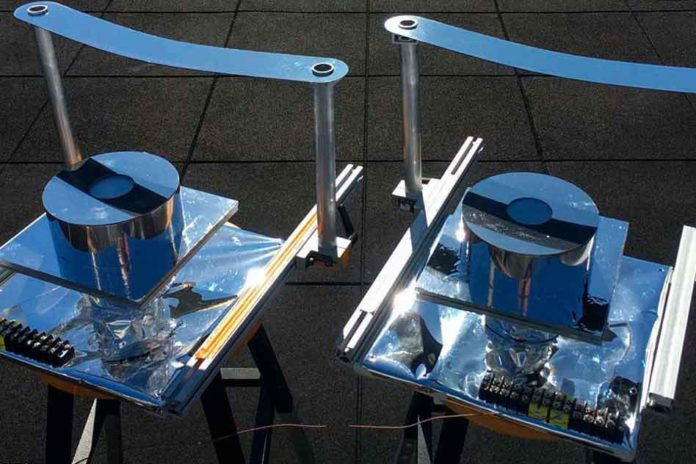MIT scientists have developed a new system that offers cooling in extreme sunny days without using power. This approach of passive radiative cooling exploits the angular confinement of solar irradiation in the sky to achieve sub-ambient cooling during the day regardless of the emitter properties in the solar spectrum.
The system can provide cooling of as much as 20 degrees Celsius (36 degrees Fahrenheit) below the ambient temperature in a location like Boston. When testing, the system offered to cool of 6 C (about 11 F) below ambient temperature.
The system works by allowing emission of heat at a mid-infrared range of light that can pass straight out through the atmosphere and radiate into the cold of outer space, punching right through the gases that act like a greenhouse. To prevent heating in the direct sunlight, a small strip of metal suspended above the device blocks the sun’s direct rays.
Scientists noted, “Other groups have attempted to design passive cooling systems that radiate heat in the form of mid-infrared wavelengths of light, but these systems have been based on complex engineered photonic devices that can be expensive to make and not readily available for widespread use.”
“The devices are complex because they are designed to reflect all wavelengths of sunlight almost perfectly, and only to emit radiation in the mid-infrared range, for the most part. That combination of selective reflectivity and emissivity requires a multilayer material where the thicknesses of the layers are controlled to nanometer precision.”
Scientists explained, “It turns out that similar selectivity can be achieved by simply blocking the direct sunlight with a narrow strip placed at just the right angle to cover the sun’s path across the sky, requiring no active tracking by the device. Then, a simple device built from a combination of inexpensive plastic film, polished aluminum, white paint, and insulation can allow for the necessary emission of heat through mid-infrared radiation, which is how most natural objects cool off while preventing the device from being heated by the direct sunlight.”
“In fact, simple radiative cooling systems have been used since ancient times to achieve nighttime cooling; the problem was that such systems didn’t work in the daytime because the heating effect of the sunlight was at least 10 times stronger than the maximum achievable cooling effect.”
Research scientist Bikram Bhatia said, “But the sun’s heating rays travel in straight lines and are easily blocked — as we experience, for example, by stepping into the shadow of a tree on a hot day. By shading the device by essentially putting an umbrella over it, and supplementing that with insulation around the device to protect it from the ambient air temperature, the researchers made passive cooling more viable.”
“We built the setup and did outdoors experiments on an MIT rooftop. It was done using very simple materials” and clearly showed the effectiveness of the system.”
Evelyn Wang, professor of physics Marin Soljačić said, “It’s kind of deceptively simple. By having a separate shade and an emitter to the atmosphere — two separate components that can be relatively low-cost — the system doesn’t require a special ability to emit and absorb selectively. We’re using angular selectivity to allow blocking the direct sun, as we continue to emit the heat-carrying wavelengths to the sky.”
“This would be useful for refrigeration applications, such as food storage or vaccines. The system might also be useful for some kinds of concentrated photovoltaic systems, where mirrors are used to focus sunlight on a solar cell to increase its efficiency. But such systems can easily overheat and generally require active thermal management with fluids and pumps. Instead, the backside of such concentrating systems could be fitted with the mid-infrared emissive surfaces used in the passive cooling system, and could control the heating without any active intervention.”
Scientists currently are working on improving the system, the biggest challenge is finding ways to improve the insulation of the device, to prevent it from heating up too much from the surrounding air, while not blocking its ability to radiate heat.
The new system is described this week in the journal Nature Communications in a paper by research scientist Bikram Bhatia, graduate student Arny Leroy, professor of mechanical engineering and department head Evelyn Wang, professor of physics Marin Soljačić, and six others at MIT.
